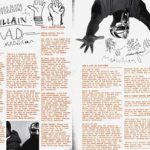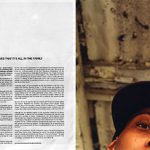Madvillain redeems the pretensions of independent hip-hop.
In the early nineties, thanks to performers like Dr. Dre and his muse Snoop Doggy Dog, hip-hop became geometrically more popular than it had ever been. In the mid-nineties, multitasking figures like Puff Daddy helped make it a brand. As this happened, hip-hop gained a self-consciousness, as all successful art forms do, and a set of beliefs: hip-hop, sayeth the faithful, is made with two turntables and a microphone; graffiti and break dancing are the appropriate activities if you aren’t rapping or d.j.ing. And with Scripture comes orthodoxy: parvenu superstars rapping about guns and women and sampling popular songs are somehow betraying the original ideals; these new popular artists are “rap,” not hip-hop; hip-hop isn’t about sampling well-known songs like Rick James’s “Super Freak” and talking about champagne—it involves “skills” and an affinity for the “truth.” It sounds, in short, like Sunday school.
Hip-hop, of course, did start with people rhyming over well-known songs, and very few hip-hop records have actually been produced with only two turntables and a microphone. This fact hasn’t stopped the revisionists. As hip-hop became the lingua franca of youth all over the world and artists like Jay-Z and Eminem made remarkable and remarkably popular records, a parallel subculture of independent labels and artists grew up around a doctrine that was almost puritan. These independent artists rue the perfidy of apostate millionaires, and moan about pop stars who abandoned the true faith. Wanna-be prophets dream of chasing the moneylenders out of the temple, even though the moneylenders built the place.
Some independent acts prove their devotion by exulting in musical and linguistic obscurity, like slightly hipper stamp collectors. Some m.c.s spend so much time scolding the popular m.c.s that they come across as schoolmarms, switches in hand. Others are so committed to resurrecting various “golden ages” of hip-hop—1979, 1988, 1993—that their work is not much different from that of Renaissance-fair revivalists dancing around the maypole. Independent pop—not just hip-hop—has in many ways become a version of graduate school, a safe zone where artists can eke out a living, take their time doing specialized work. In most cases, this is the last thing a popular musician should be doing. But on “Madvillainy” (Stones Throw) the duo Madvillain—the m.c. MF Doom and the producer Madlib—demonstrate that hiding out can be the right move. Madvillain’s music is accessible but idiosyncratic, catchy but soaked in noise, lighthearted but full of abstractions. Madvillain is why independent hip-hop isn’t such a bad idea; this group needed breathing space.
Some fourteen years ago, MF Doom (Daniel Dumile) signed with a major label, Elektra, as part of the group KMD, which included his brother Subroc. In 1991, KMD put out “Mr. Hood,” a delightful, unusual record that was often lumped with De La Soul’s 1989 album “3 Feet High and Rising.” De La Soul combined playful samples of well-known funk songs and a friendly, Day-Glo graphic sense. KMD was a darker, stranger group, and never quite fit that template. Doom, then known as Zev Love X, has a slightly obstructed voice, as if his tongue were too big for his mouth. KMD’s samples made reference to racial unease. In 1993, Elektra dropped KMD, and refused to release its second album, “Black Bastards,” reportedly because of controversial artwork (a drawing of a Sambo figure hanged on a gallows). Later that year, Subroc was hit and killed by a car.
Doom resurfaced with his new name—from Marvel Comics’ Dr. Doom—in the late nineteen-nineties, releasing a few independent twelve-inch singles and then, in 1999, the full-length album “Operation: Doomsday.” It was a furiously odd thing, assembled from sweet nineteen-eighties R. & B. and nailed shut by Doom’s glottal, pained rhymes. (Doom has since released records under the names Viktor Vaughn and King Geedorah.)
Doom’s partner in Madvillain, the West Coast producer Madlib, was born Otis Jackson, Jr., and emerged in the mid-nineties with the group Lootpack. He established himself in 2000 with “The Unseen,” an album by his alter ego Quasimoto. (He created the character by speeding up his voice slightly.) As hip-hop producers were moving toward keyboards and drum machines and away from samples of records, which are expensive to license, Madlib stuck stubbornly to samples of jazz and rock records—especially jazz records. His sound was distinct enough to avoid anachronism: of a tradition but unique. In 2003, Madlib was given access to the vaults of Blue Note records, and he created a long, effective montage of sixties and seventies jazz called “Shades of Blue.”
Madlib and MF Doom are both comfortable with what might be called the “casual noise” of hip-hop, the sonic by-products of the act: spit hitting a microphone, the crackle of an old record, the sibilant hum of a low-resolution digital sample. The voices and samples on “Madvillainy” sound as if they’d been coated with dust, fried, dropped, rolled around, and then fried again.
But “Madvillainy” is hardly a difficult record. MF (which stands for Metal Face, among other things) Doom, who appears on the cover masked, looking like an extra from “Alexander Nevsky,” takes a deep pleasure in words: alliteration, internal rhymes, and pure sound. The point of “Madvillainy” is largely poetic—celebrating the language of music and the music of language. It’s not hard to quote Doom. From “Money Folder”: “Egads, she got enough style to start three fads.” From “Raid”: “The metal fellow been rippin’ flows / since New York plates were ghetto yellow with broke blue writing.” (Who wouldn’t like to hear more rhymes about license plates?) There are many references to science fiction and TV. Doom can turn a corner with a quote reminiscent of “Star Trek” or “The West Wing” (“Sir, request permission to be candid.” “Granted”), touch on commercials (“Better get Maaco”), and end with an enticing metaphor all his own (“more soul than a sock with a hole”). Thankfully, Madvillain doesn’t define itself against the mainstream. The only reference to popular m.c.s comes in a song called “Figaro”—Mozart’s guy—and it’s deliciously subtle: “The clever nerd / the best m.c. with no chain ya ever heard.”
Most of Madlib’s beats are made from samples of records, though it is hard to say which ones, even in a general way. Is the lovely, decaying piano figure in “All Caps” from a jazz record? An English skiffle record? A documentary about whales? “America’s Most Blunted” begins with a sample of Steve Reich’s “Come Out,” and then stumbles into a swaggering funk pattern. The three instrumental tracks are some of the album’s best moments, brief as they are: “Do Not Fire!” could be the theme of a Cuban kung-fu movie, and “Supervillain Theme” sounds like the work of an accomplished rock band from a country that the United States does not maintain diplomatic relations with.
After a few repetitions, a sample becomes known but doesn’t necessarily stop being strange. The imperfections in whatever is being sampled are retained, the stresses and flaws and cracks. There is a tactile quality to “Madvillainy,” which leads us to the smoking gun of the record, if there is one: marijuana. There are repeated allusions to weed and several samples of a 1971 record called “A Child’s Garden of Grass: A Pre-Legalization Comedy.” The key sample: “In fact, everyone finds that they’re more creative stoned than straight.”
For most of us, this is poppycock, but Doom and Madlib succeed in translating the heightened physical sensitivity and associative facility of the stoned mind into concrete sound. Madlib, especially, seems able to hide music inside other music. His samples lie on each other like double exposures, or like a cassette tape that allows the previous recording to bleed through the new one. “Strange Ways” sounds like several songs constantly competing to achieve dominance. Doom, happily, is undisturbed. The narcissism of the stoned can be a gift.
But not always. Quasimoto appears as Lord Quas on the mildly philosophical “Shadows of Tomorrow”: “Today is the shadow of tomorrow, today is the present future of yesterday, yesterday is the shadow of today, the darkness of the past is yesterday.” Somewhere, a dorm room is missing its poster.
Madvillain was thinking more clearly when this album was assembled from scenes into narrative. The twenty-two songs on “Madvillainy” cohere and zip by. (Once or twice, Doom drifts over the beat without engaging it.) “Madvillainy” makes a convincing case that, however you choose to pray, two of hip-hop’s many dogmas still obtain: Every sound can make a song. All words make sense.
http://www.newyorker.com/critics/music/?040412crmu_music

